| 1 | Puff adder |
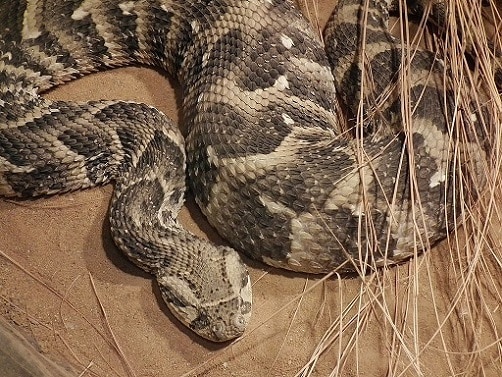
Location: all of sub-Saharan Africa.
In Africa, Bitis is a large family of venomous vipers which has endless different forms. Some live in a single rugged mountain range, while others patrol shrubland and desert. The Bitis genus has 18 confirmed members, and the puff adder (Bitis arietans) is overwhelmingly the most common. This may be the most common venomous snake in all of Africa, as it inhabits every single sub-Saharan country, plus Saudi Arabia and Oman.
Puff adders measure 1-1.5 metres, and have a thick, stubby body. They’re mainly an ambush snake, lurking in knee high thickets, waiting for rodents (their main prey) such as four-striped grass mice to pass. With such a thick body, they can kill a rodent with their crushing weight alone, but corrosive venom is their main power. Puff adders have a mainly cytotoxic venom which causes severe swelling, necrosis and typically leaves victims alive, but with deformities and possibly amputation.
Puff adders have various skills: they’re strong swimmers, disguise their own chemical scent, and can produce 156 babies at once. With flexible habitats, including forests, grassland and savannah, this has allowed them to take over all of Africa. Despite the black mamba’s nightmarish reputation, puff adders are believed to top the annual African snakebite rankings.
| 2 | Gaboon adder |
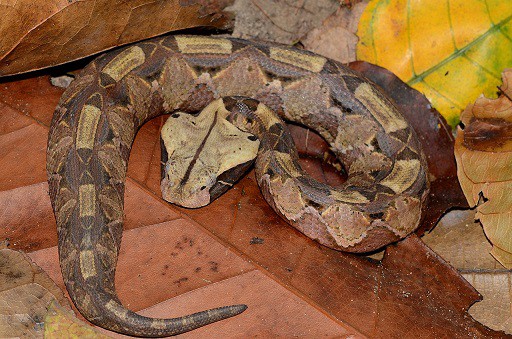
Location: central Africa.
The second most widespread Bitis family viper. While gaboon adders aren’t as common as the puff adder, in many respects, they’re a more finely tuned and efficient snake machine. Gaboon adders are found in countries such as Uganda, Tanzania, Kenya, Zambia, as far west as Nigeria. They’re an absolute tank of a snake which reaches 2.2 metres at most, and has an extremely thick body, particularly for a snake which isn’t a constrictor. They’re the heaviest snake in Africa, and one of the heaviest worldwide, joining the east diamondback rattlesnake. Their fangs hold the global record for length, maxing out at 5.5cm (2.2 inches).
Then there’s their camouflage. A puff adder’s beige shades blend superbly with thickets, but gaboon adders are on another level, with segmented patterns that mimic leaves perfectly. No snake of such bulk and size has as effective a camouflage, as this snake can be invisible on a forest floor.
Gaboon adders mainly inhabit woodlands and forests edges, plus tea and coffee plantations. This is another dangerously venomous snake; yet another global record is for the highest recorded venom yield, with 2400mg recorded in one experiment. As with puff adders, the bite lacks neurotoxins and mainly causes local tissue destruction.
| 3 | Horned adder |
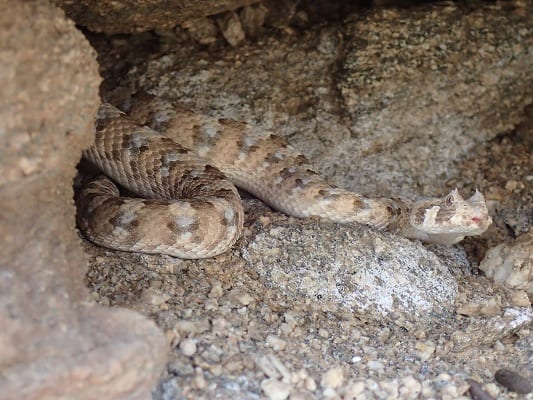
Location: southern Africa.
This 30-40cm viper lives further south, where it has a large range, including South Africa, Namibia, Mozambique and Zimbabwe. Horned adders (Bitis caudalis) are encountered commonly by ordinary Africans, and mainly favour dry areas, such as semi desert, dry shrubland and the bottoms of rocky canyons.
This member has two classic physical features, the first being a single horn above each eye, which is actually a single extended and sharpened scale. The second is a huge variety in colour, which fits with each location. Those in rockier arid country are grey, while those in the sandy Namib desert have reddish-beige shades.
Lizards are their main prey, including the bushveld lizard (Heliobolus lugubris), but horned vipers also eat plenty of rodents. This is one of the shorter Bitis species, at an all time record of just 51.5cm recorded in southern Botswana. But don’t confuse diminutiveness with timidness. When cornered, the horned adder will strike without thinking, beginning by coiling into a Z shape, with their head tilted back slightly. They keep their mouths gaped and their fangs visible, and lunge so forcefully that their entire body can be lifted off the ground. Estimates on the toxicity vary, with an LD50 score ranging from 0.15-1.2mg. However, both of these well outstrip a cottonmouth (2mg). The venom yield was estimated at 85mg per bite, and symptoms include nausea, vomiting, severe pain, and agonising blistering and necrosis around the bite site.
| 4 | Southern adder |
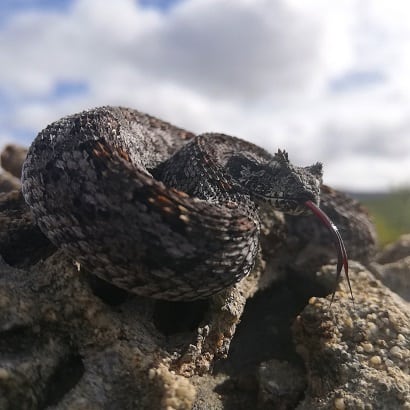
Location: a tiny pocket of South Africa.
While puff adders control almost the entire continent, the southern adder has been pushed back to one narrow corner. Bitis armata resides in just one country: South Africa, and only then the extreme southwest. They can be found in the countryside surrounding Cape Town, normally in heathland or shrubland with an abundance of limestone rock. This is a steely-grey species, which is highly proficient at blending into bare rock. They also love to hide in thick grass tussocks, and prefer moister environments to the dust-loving horned adder.
Very little is known about the venom of this species, and there are no detailed case studies of bite victims. However, a 2020 study did find a dose of postsynaptic neurotoxins. Whether these are powerful enough to paralyse a human victim, or even cause slurred speech and twitching eyelids, is a mystery, but the berg adder is similarly sized and is more than capable of causing chaos in human brain signals.
The southern adder is a horned species, yet they look more like solid tufts of hair, eyelashes which went wrong. Much of their South African habitat has been destroyed, and they’re now listed as vulnerable by IUCN. Give this snake a wide berth, just like all Bitis family vipers.
| 5 | Berg adder |
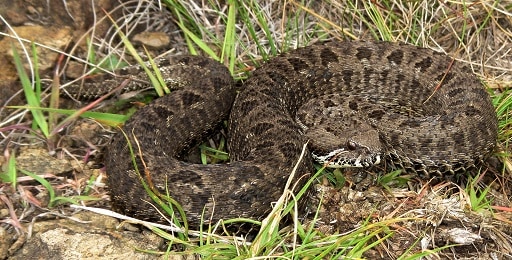
Location: South Africa, Zimbabwe.
The most likely Bitis viper to stumble across in mountain ranges in southern Africa. The Drakensburg mountains are one of their hotspots, where this adventurer found them to be the second most common snake. Berg adders appear in Zimbabwe, at altitudes up to 3000 metres, and usually above 1500 metres. This is a high altitude species which will never be found in cities like Johannesburg or a dusty desert in southern Namibia. Berg adders like moist areas with plentiful long grasses and rocks to bask on in the sun, commonly right next to hiking trails.
Unlike the puff adder, berg adder venom is one of the most neurotoxic of the Bitis family. One highly detailed study documented 14 bites from 1987 to 2003. All experienced local cytotoxic effects, and in 13, the symptoms became systemic. These included altered taste, drooping eyelids, visual disturbances, and swallowing difficulties (dysphagia). Most disturbingly, 10/13 patients experienced respiratory failure. All of these are connected to disruption of brain signals. One of the patients, a 42 year old man, was hospitalised for 114 days.
The record length for a berg adder was 60cm and the average is 30-40cm. This family member packs a lot of punch for being so small.
| 6 | Namaqua dwarf adder |
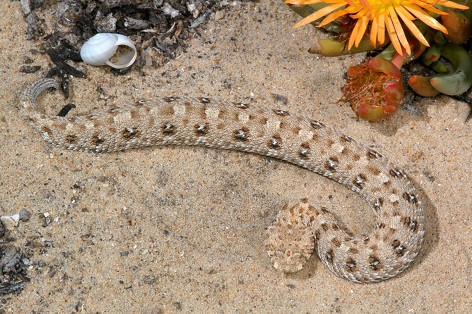
Location: Namibia, Namaqualand (South Africa).
A tiny adder which reaches a maximum of just 27.6cm, and an average of 20-30cm. Namaqua deserts live a harsh life, dwelling solely in the bone dry deserts in southwest Africa, particularly in the Namib desert. They thrive on sand dunes, which they traverse using a rare sidewinding locomotion. Namaqua dwarf adders are nearly always a sandy beige, which gives them immense camofuage, and allows them to use their favoured hunting strategy: ambush.
This viper prefers to flee rather than fight, but when cornered they’ll hiss loudly, and make a mixture of dummy and all too real strikes. Their venom causes mainly local symptoms, like swelling, discoloration and oozing pus. Namaqua dwarf adders are not just the smallest Bitis member, but the smallest confirmed viper worldwide.
Living in such parched landscapes, Namaqua dwarf adders have very poor survival rates, just 39-56% per annum, which is far lower than other vipers. This is a generalist feeder which eats whatever the unforgiving desert offers them. Their favourite prey is Knox’s desert lizard (Meroles knoxii), followed by the Namaqua rain frog and Austen’s thick-toed gecko.
| 7 | Ethiopian mountain adder |
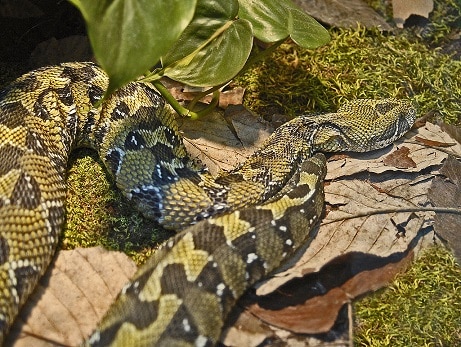
Location: only Ethiopia.
A Bitis viper found only in Ethiopian mountain ranges, usually at altitudes of 1700-2800 metres. Bitis parviocula was discovered in 1977, and is a mysterious snake whose lifestyle has barely been studied. Within their Ethiopian mountain kingdom, they seem to pop up anywhere. One was found in grassland by a small stream, another in long grasses outside a brewery, and another in a forest clearing by an old coffee plantation.
This species reaches at least 130cm, making it one of the longer Bitis vipers. It’s theorised that Bitis parviocula kills several Ethiopian people each year, but before 2011, the venom’s properties were completely unknown. That year, a study compared Bitis parviocula venom to puff adder venom. It found a slightly weaker LD50 score of 1.56mg versus 1.35mg in mice. But the minimum haemorrhagic dose, the quantity required to create a 10mm circular ring of haemorrhaging, was significantly higher, at 0.88mg versus 1.7mg for puff adders. Keepers testify that Ethiopian mountain adders have a milder temperament, but react furiously if touched or provoked in any way.
| 8 | Red adder |
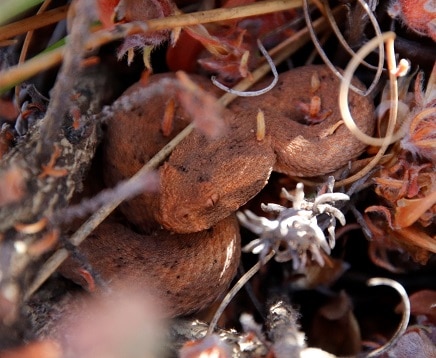
Location: western South Africa.
The red adder is found exclusively in south Africa, with no crossover into Namibia. This is mainly a neurotoxic adder, which is small, and slithers with fast, jerky movements. Bitis rubida is a highly variable species. Some are red as promised, but others are grey or a more typical viper beige. Some have black and white shades like a 1940s film.
The red adder was only discovered in 1997, at which point it was already deemed threatened by habitat loss. Red adders generally live in mountainous areas, and in western South Africa, they can sometimes be found side by side with horned adders (Bitis caudalis). However, they never appear alongside the southern adder (Bitis armata), which only appears in coastal regions of the southern Cape.
At 30-40cm, this is another short viper, though not tiny like the Namaqua dwarf viper. In 2013, a pregnant red adder was captured hiding beneath rocks. She measured 43.4cm, and soon gave birth to 11 healthy babies (live young). These ranged from 14.5-15.8cm.
| 9 | Rhinoceros viper |
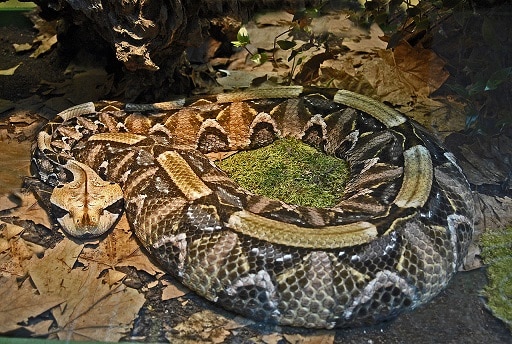
Location: west Africa.
This species is most closely related to the gaboon viper, but is separated by two small “horns”. These are located above its nose, rather than above the eyes like a horned viper in Namibia. Rhinoceros vipers are brute of a snake which can reach 200cm, with a thick body, and are found in Ivory Coast, Togo, Liberia, Sierra Leone and other western African nations.
Rhinoceros viper venom lacks neurotoxins, and mainly causes local chaos like necrosis and tissue swelling. According to a 2008 study, monkeys fear them just as much as we do. Sooty mangabey monkeys were followed for 429 days, and they crossed the paths of rhinoceros vipers 43 times. Each time, they responded with cries and alarms. Interestingly, this monkey species shows no fear of forest cobras, which is probably because they’re too small to eat them.
Rhinoceros vipers have immense camouflage due to their patterns, but the scale microstructures are also involved. Each black scale has a series of leaf-like microstructures and nano ridges, which increases light absorption compared to non-black scales, while causing light reflectance to plummet 4 fold.
| 10 | Many-horned adder |
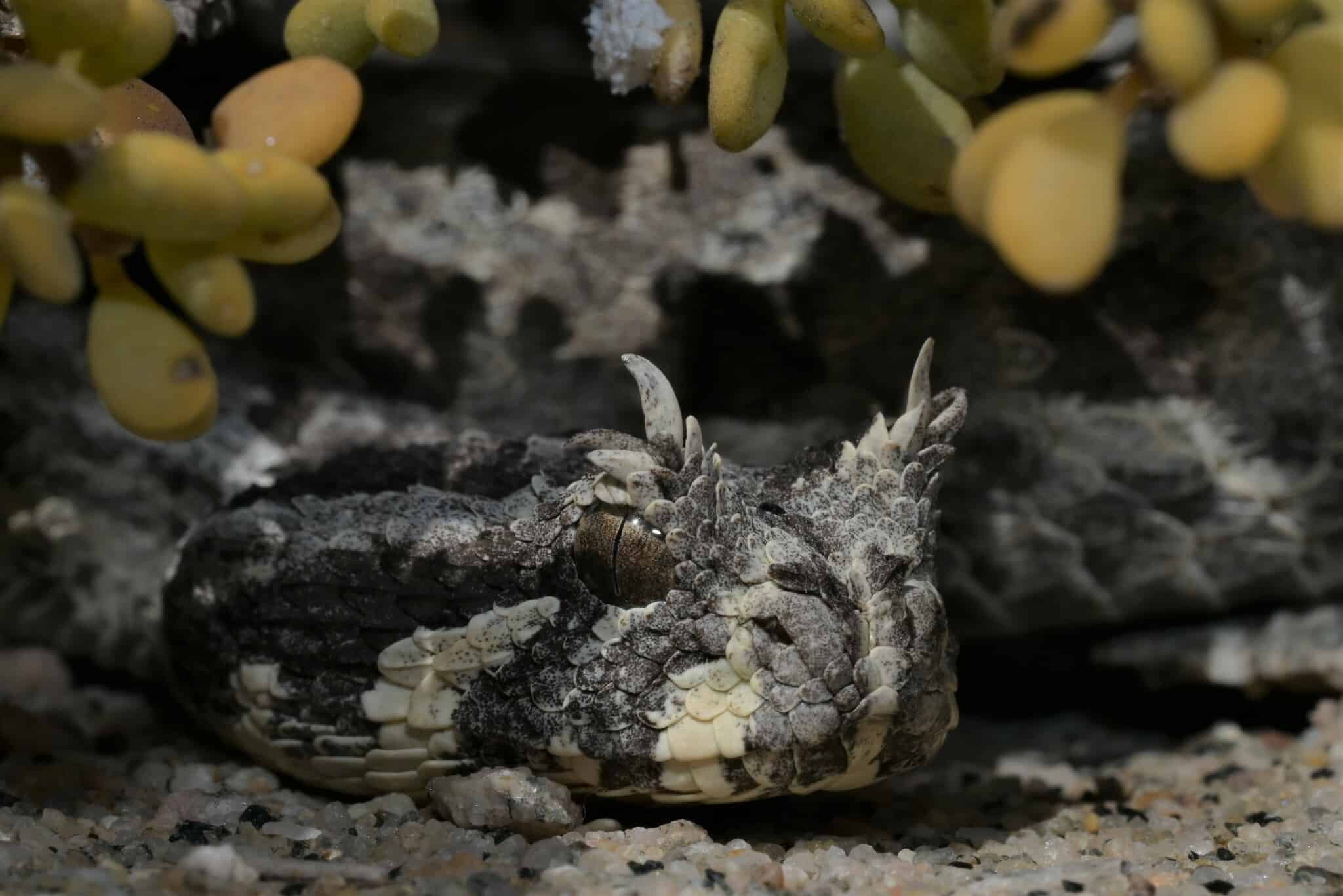
Location: extreme southwest Africa.
A neighbour of the horned adder, which is encountered much less frequently. Many-horned adders are found in two countries: western south Africa (Namaqualand) and southern Namibia over the border. They average at 30-50cm and the all time record was 75cm, for an individual raised in captivity. Though many-horned adders vary in colour, it isn’t as extreme as with their neighbour Bitis caudalis. They have consistent dark rectangular blotches, and the colour beneath is typically grey, sometimes reddish-brown.
One glance at the image above tells you everything: Bitis caudalis has perhaps the most complex “horns” of any snake, which look like horns giving birth to new sets of horns. Exactly why they developed is a mystery. It may be as simple as intimidation, causing an ever accelerating arms race whereby the snake with the craziest horns won. Many-horned adders prefer drier areas, including rocky semi-deserts, but can also be found on heathland on mountainous slopes.
One study tested 5 members of the Bitis family. Horned adders (Bitis caudalis) had extremely indiscriminate venom, with coagulant activities against birds, mammals, lizards, and birds alike, but the many-horned adder only affected mammals and birds. Its venom had powerful anticoagulant activity, destroying clotting agents like fibrogenin so that blood flows freely. Many-horned adders have a nervous disposition and will strike if they feel slightly threatened.
